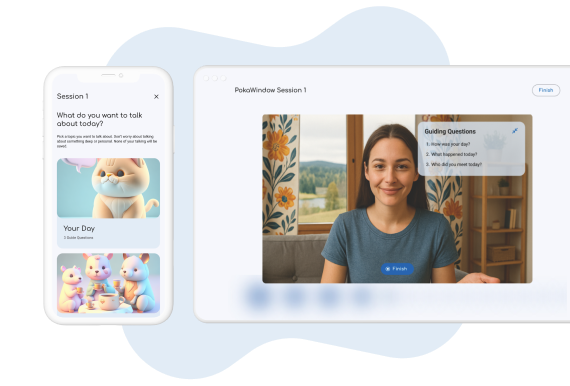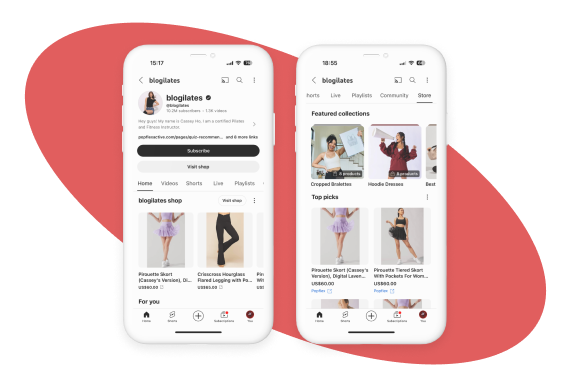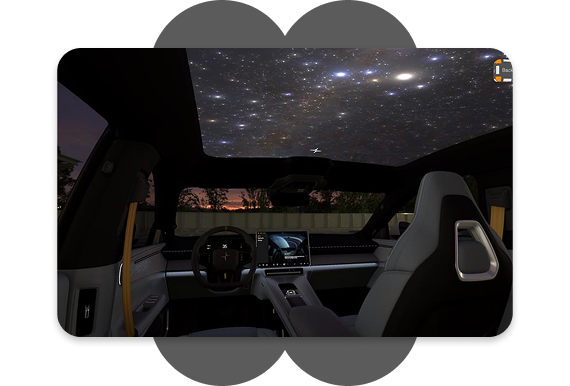Star Visit: An In-Car AR Experience
Concept design and validation of an in-car AR wellness experience for Polestar, a luxury electric vehicle brand. A comprehensive study combinig conventional design research approach with soma design.
Contribution
comprehensive research ✺ concept design ✺ validation ✺ research paper
Team
1 product researcher/designer (me) ✺ Polestar Visualization team ✺ 1 user researcher (industry supervisor) ✺ 1 design researcher (academic supervisor)
Duration
6 months (Jan - June 2024)
Possible Impact
Strategic Insight for Future Product Development
Innovation Leadership & Market Differentiation
Enhanced Customer Experience & Brand Loyalty

Overview
The final concept, Star Visit, leverages Augmented Reality (AR) technology to transform the in-car experience and promote driver wellness while the vehicle is charging. Utilizing Polestar’s signature panoramic roof, AR projects an expansive, immersive display onto the roof, creating a seamless and visually engaging experience. This multisensory experience aligns with the duration of the charging session and seamlessly offers a package of wellness interventions, including deep breathing nudges and soothing sound baths, all within a space-themed narrative where the Polestar vehicle becomes a futuristic spaceship.

System diagram of Star Visit
A key wellness feature is the breathing intervention, which not only incorporates AR visuals but also integrates tactile stimulation through the car’s built-in seat massage functionality. This combination of visual, auditory, and physical engagement provides a holistic relaxation experience. By aligning with Polestar’s innovative and forward-thinking identity, Star Visit reinforces the brand’s commitment to luxury, technology, and well-being, making each charging session an opportunity for rejuvenation and escapism.
Details
Effortless Onboarding: A Seamless Start to the Experience
The experience starts effortlessly—no buttons needed. As soon as users put on their AR glasses and recline their seat after starting the application, the system automatically detects readiness and initiates the experience, ensuring a smooth, immersive transition.

Travel to and from the Star: The Unique Wellness Experience
The panoramic roof transforms into a starry night sky, with one designated star highlighted above. Audio cues guide the journey, reducing cognitive load and ensuring usability of the experience.
The user then travels through the universe, arriving at the star they've been guided to.
Upon arriving at the star, users are presented with brief educational insights, enriching the experience with a sense of discovery. The star gently pulses, dimming and brightening in harmony with soft touch stimulation from an air pillow beneath their neck, subtly guiding them to practice deep, mindful breathing. A calming layer of meditative sound enhances the overall sense of relaxation and well-being.
The experience lasts until just before the car finishes charging. At that point, a reversed scene begins, guiding the user back through the universe to Earth, seamlessly marking the end of both the wellness journey and the charging session.
Approach
This project focused on a comprehensive design and research process to create an innovative in-car leisure experience. Using a soma design approach—centered on felt, embodied experiences—various soma design methodologies were applied within a larger Research-through-Design (RtD) framework.
Understanding the design space
I began with desk research and an in-depth literature review to understand the Polestar brand, the electric vehicle (EV) industry, and emerging trends in in-car experiences. This provided a foundation for understanding the market and technological landscape. I then conducted semi-structured interviews with 17 Polestar experts, gathering real-world insights into EV technology, user behavior, and design opportunities. A key takeaway from these conversations was the potential to improve user experiences during charging, which typically lasts a minimum of 30 minutes.

Thematic analysis on expert interview. Specifics are under NDA.
Ideation Workshop
To generate a wide range of ideas, I organized and facilitated an ideation workshop with 5 car UX designers and 5 interaction design students. The workshop included sensitizing activities to spark creativity and multiple brainstorming sessions focused on in-car leisure experiences that promote wellness. This collaborative session produced a rich variety of ideas.

Refining Ideas & Narrowing Down to One
From the workshop, I distilled 8 core themes and developed 6 concrete concepts based on these themes.

To prioritize and evaluate these ideas, I employed a prioritization matrix—measuring the value for Polestar (Y-axis) against development feasibility (X-axis). This process helped identify the most promising concept: “Driving to the Stars”—an immersive AR experience designed to enhance wellness during charging.

Storyboard
To visualize the user journey and flow, I created detailed storyboards that mapped out the core user experience. These storyboards served as foundational tools for aligning the vision with both the team and stakeholders.

Design Exploration - Autobiographical Design
For design exploration, I employed an autobiographical design method, a key approach in soma design. I rapidly prototyped visuals and tested them within the actual car environment, documenting my felt experiences across multiple sessions. This iterative process was essential for refining the visual, tactile, and auditory elements of the design. By personally experiencing each iteration, I was able to deeply understand and enhance the multisensory aspects of the concept.

User Study
To validate the design, I recruited 10 participants from Polestar’s internal testing pool, ensuring they had relevant experience with VR and were available for testing. The study was conducted using a Polestar VR simulator (Meta Quest 3), with tactile stimulation provided through a Wizard-of-Oz setup.

Data collection was multi-faceted, including body maps (left), soma trajectories (right), video recordings during the VR session, and semi-structured interview audio recordings. These data points provided a holistic view of the participant’s embodied experience, helping further refine the final design.

Results
I conducted a thematic analysis of the collected qualitative data, using inductive coding. Five key themes emerged, ranked by significance:
① Sensation of Deep Relaxation
The most prominent theme was the feeling of deep relaxation. Body map data revealed a clear shift: participants recorded their pre-experience emotions as heavy, stressed, tired, and asymmetric, which transformed into feelings of lightness, relaxation, and symmetry post-experience.

Soma trajectory data supported this, with 60% of participants indicating a steady increase in relaxation over time. Two other trends (b) and (c) showed that while participants ultimately felt relaxed, some experienced stress during specific moments—particularly while traveling or interacting with the star.

Semi-structured interviews echoed these findings. Participants provided representative feedback such as:
- "At the star, you come to relax a lot more, and it feels like you're melting into the seat."
- "It felt like a meditation practice with the music and the touch sensation. It got me breathing deeper, and I spaced out a bit […] the touch nudged me to sync my breathing with the star’s light, which I really enjoyed."
Traveling Away from Reality
The second most common theme was the sensation of escaping reality. Participants consistently felt as though they were transported to another world.
Some notable quotes include:
- "It made you feel like you were somewhere else […] like you were traveling through space and looking at a big star. It helped take you away from everything, which was nice."
- "The traveling made time feel shorter. If I was actually charging a car, I think it would make the wait feel much quicker, which added nicely to the experience."
Harmony of Multisensory Elements
Participants noted that the combination of visual, auditory, and tactile elements felt well-balanced, enhancing the overall experience. No specific sensory element was highlighted as out of harmony, but there was feedback regarding the need for personalization—such as adjusting the strength of tactile feedback, sound volume, and types of sound to better suit individual preferences.
Limitation of VR and Potential of AR for In-Car Experiences
The most significant technology-related feedback centered around the limitations of VR. Participants noted issues such as the jitteriness and heaviness of VR headsets, which led to discomfort and dizziness during use. However, there was a strong positive response toward integrating AR into the experience. AR glasses were perceived as lighter, more comfortable, and easier to use, especially in social situations. Participants expressed enthusiasm about the potential of AR for in-car applications due to its more seamless integration with other vehicle functions.
Enthusiasm for Integration
All participants responded positively to the concept, expressing enthusiasm for its real-world application. Some participant quotes included:
- "This would be a really unique and valuable addition to the car, especially with a focus on mindfulness and breathing."
- "I’d love to have this in my car. It would be perfect for relaxation."
- "I hope this comes to reality."
Next Steps
- Testing the concept with AR glasses in real-world scenario
- Developing system to consider social aspects
- Iterating with personalization options on audio and tactile stimulations
- Testing with multiple options of stars to explore
- Assessing adaptability of AR to external environments and iterate based on the results





